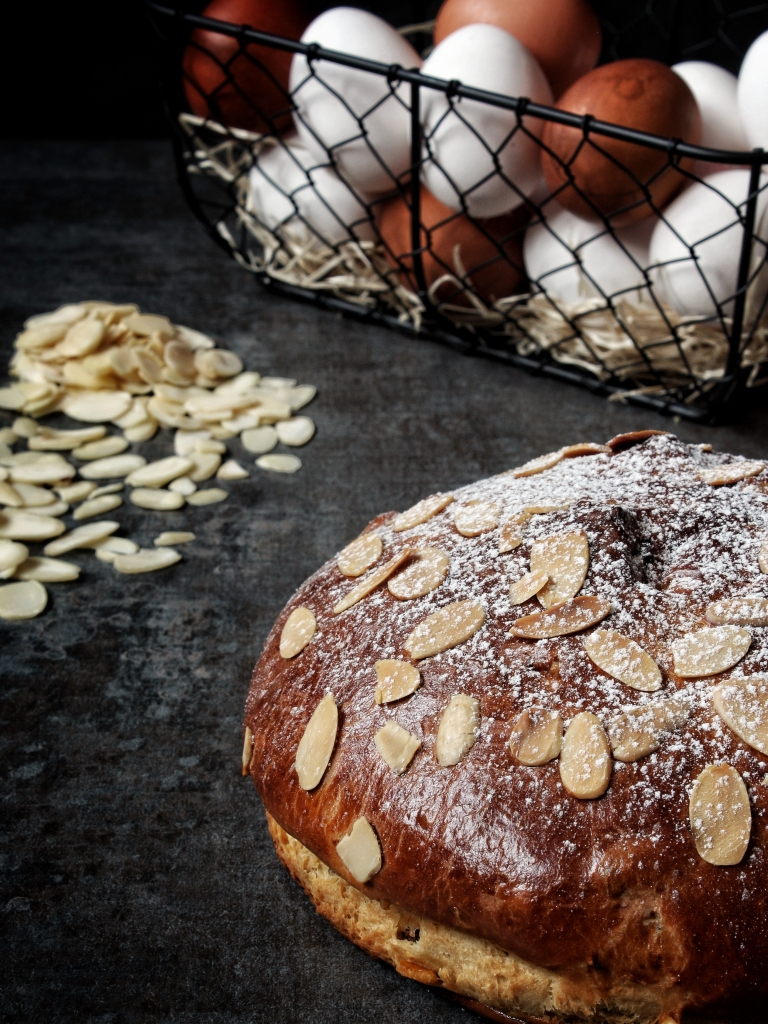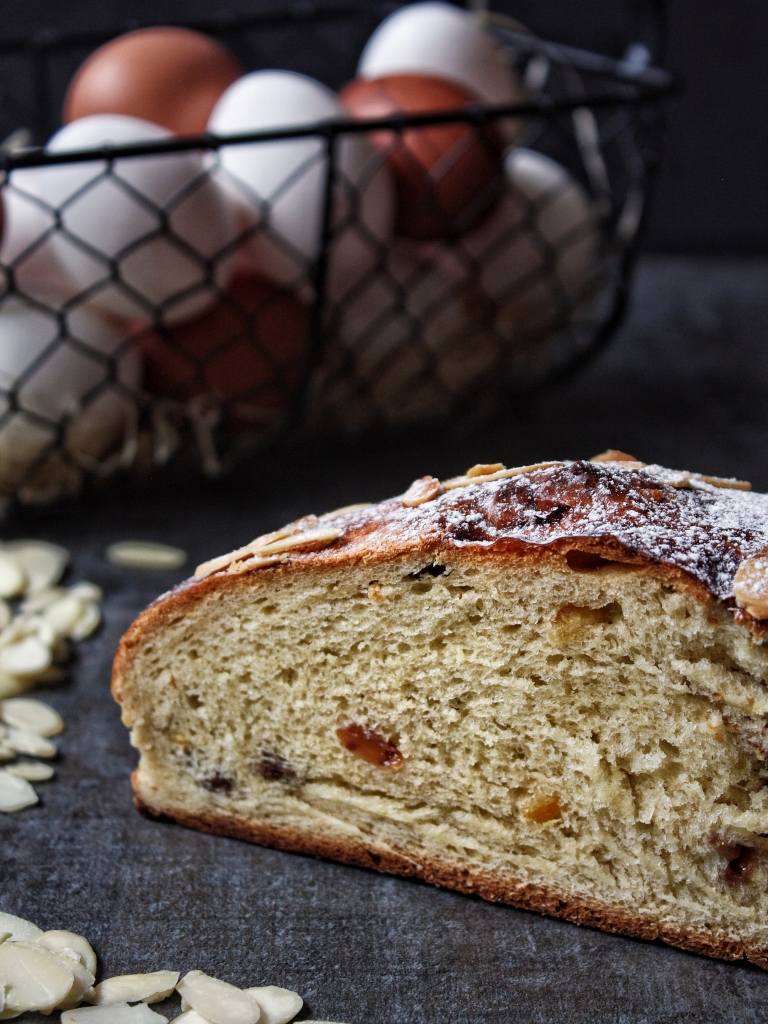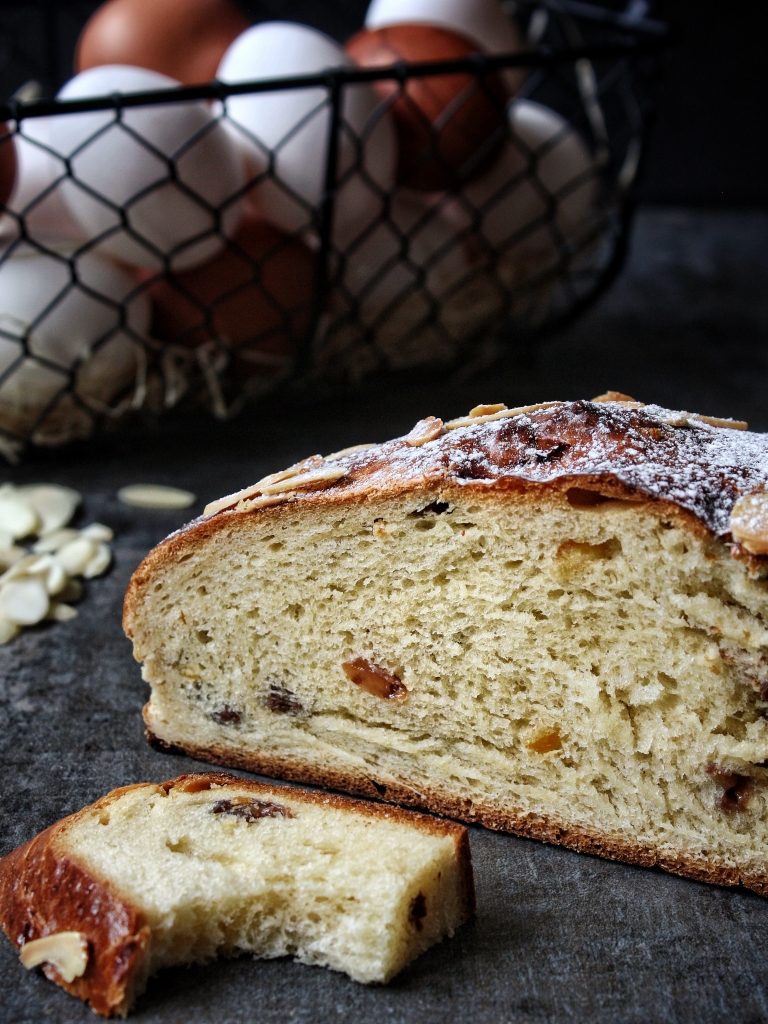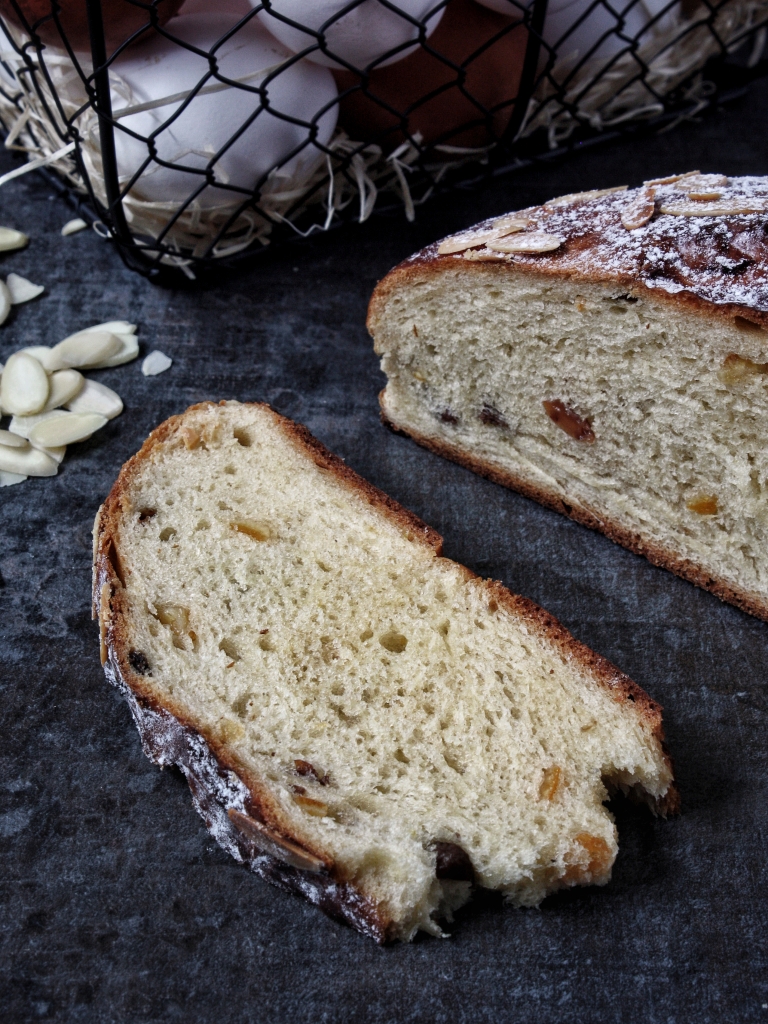Imagine Christmas without Santa Clause (Ježíšek) and Easter without the Easter bunny, well that is exactly the same as the delicious breads we bake for those special occasions. So with Chritmas we have Sweet Christmas bread (Vánočka) and with Easter only a few days away we have the delicious Mazanec.

You may be wondering what the difference is between Sweet Christmas Bread and a Sweet Easter Bread. In both cases it is a leavened dough, dried fruits such as raisins are added to the dough, as well as candied orange peel or almonds, however, the process of making is quite different. And the recipe varies from recipe, usually each family has its own traditional recipe, which is passed down from generation to generation.
So what is our family Easter treat recipe? It is simple, just try it, soak the raisins in black tea before use and mix the candied orange peel into the dough. I hope you enjoy it.

This recipe was created in collaboration with Czech centers that promote the Czech Republic abroad. And what exactly are the Czech Centers? It is a contributory organization of the Ministry of Foreign Affairs of the Czech Republic. They connect the presentation of our country, for example in the field of culture and tourism. The network of foreign representations of the Czech Republic is an active tool in the field of public diplomacy.
Dough:
- 280 g plain flour
- 50 g caster sugar
- 125 ml milk
- 15 g fresh yeast (1/2 bag of dried yeast)
- 2 egg yolks + 1 egg yolk (mixed with 1 tablespoon of milk)
- zest of 1 lemon
- 70 g melted butter (cooled)
- 25 g raisins pre-soaked in black tea for approx. 30 min (1 bag of black tea per 250 ml of water)
- 25 g candied orange zest
- chopped almonds to sprinkle on top
- 1 pinch of salt
+ powdered sugar for sugaring after baking
Method:
- Prepare the yeast – mix 4-5 tablespoons of lukewarm milk with a teaspoon of sugar and yeast. Leave the yeast to rise in a warm place.
- Sift the flour with a pinch of salt, add sugar and lemon zest. Make a “well” in the mound and add 2 egg yolks and melted butter (it mustn’t be hot). Finally, add the yeast and make a smooth dough either by hand or by using a kneading robot / food processor.
- Put the prepared dough in a bowl and dust it with flour, cover it with a cloth and let it rise in a warm place for about an hour and a half.
- Prepare strong black tea – infuse one teabag of black tea in 250 ml of boiling water, put the raisins inside and leave in the liquid for at least 30 minutes, then drain the raisins through a sieve and let drip.
- After an hour and a half of leavening, knead the raisins and candied orange zest into the dough and leave to rise for another 30 minutes in a bowl under a tea towel.
- Once the bread has risen, knead the dough on a floured surface and transfer it to a baking sheet lined with baking / greaseproof paper. Score the bread on the top (“x” shape), smear with beaten egg yolk mixed with a spoonful of milk, sprinkle with almonds and leave to rise for another 20 minutes. Preheat the oven to 160°C / 320°F /gas 3 and bake for about 35 minutes.
- Serve with butter, honey and/or jam according to your taste.
Translation of the recipe and method: J. Seidlová

Zkuste si představit Vánoce bez vánočky a Velikonoce bez mazance. Ne, to prostě nejde, jsou to tradiční symboly, které patří na naše stoly.
Možná se budete ptát, jaký rozdíl je mezi vánočkou a mazancem. V obou případech se jedná o kynuté těsto, do těsta se přidává sušené ovoce jako jsou například rozinky, dále také například kandovaná pomerančová kůru nebo mandle, nicméně proces zpracování se liší. A liší se i recept od receptu, obvykle má každá rodina svůj tradiční recept, který se dědí z generaci na generaci. A jaký je tedy ten náš rodinný mazanec? Vyzkoušejte jej, rozinky namočte před použitím do černého čaje a do těsta zamíchejte kandovanou pomerančovou kůru. Věřím, že vám bude chutnat.
Tento recept byl vytvořen ve spolupráci s Českými centry.

Těsto:
- 280 g hladké mouky
- špetka soli
- 50 g cukru krupice
- 125 ml mléka
- 15 g čerstvého droždí (1/2 sáček sušeného droždí)
- 2 žloutky + 1 žloutek na potření (smíchaný s 1 lžící mléka)
- kůra z 1 citronu
- 70 g rozpuštěného másla (vychladlého)
- 25 g rozinek předem namočených v černém čaji cca 30 min (1 sáček černého čaje na 250 ml vody)
- 25 g kandované pomerančové kůry
- sekané mandle na posypání
+ moučkový cukr na pocukrování po upečení
Postup:
- Připravte si kvásek – část vlažného mléka (4-5 lžic) smíchejte s lžičkou cukru a droždím. Nechte vzejít kvásek na teplém místě.
- Prosejte mouku se špetkou soli, přidejte cukr, nastrouhanou citronovou kůru a vytvořte důlek, do kterého přidejte 2 žloutky a rozpuštěné máslo (nesmí být horké). Nakonec přidejte kvásek a ručně nebo pomocí hnětacího robotu vypracujte vláčné těsto.
- Vypracované těsto dejte do mísy a poprašte ho moukou, zakryjte utěrkou a nechte na teplém místě vykynout zhruba hodinu a půl.
- Připravte silný černý čaj – sáček černého čaje zalijte vroucí vodou (250 ml), do čaje nasypte rozinky a nechte je minimálně 30 minut v tekutině, poté rozinky přes sítko sceďte a nechte okapat.
- Po hodině a půl kynutí zapracujte rozinky a kandovanou pomerančovou kůru a nechte dalších 30 minut kynout v míse pod utěrkou.
- Jakmile mazanec nakyne, na pomoučené ploše těsto propracujte a přeneste na plech s pečícím papírem. Mazanec nahoře nastřihněte do tvaru kříže, potřete rozšlehaným žloutkem s lžící mléka, posypte mandlemi a nechtě ještě asi 20 minut kynout. Pečte v předehřáté troubě na 160 °C asi 35 minut.
- Podávejte s máslem, medem anebo marmeládou dle chuti

